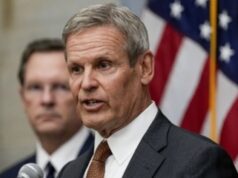After 43 days of testimony at Trump’s civil fraud trial…..a report

Former President Donald Trump gives a thumbs up as he returns to the courtroom from a break at New York Supreme Court, on Dec. 7, 2023, in New York
After hearing from 40 witnesses over 43 days, Judge Arthur Engoron sounded almost wistful as he presided over the last day of testimony in former President Donald Trump’s civil business fraud trial.
“In a strange way, I’m gonna miss this trial,” he said Wednesday.
Things aren’t over yet in the case, in which New York Attorney General Letitia James has accused Trump of inflating his wealth on financial statements used to secure loans and make deals.
Closing arguments are scheduled for early January. The judge has already ruled that Trump is liable for making fraudulent statements, but other claims and a potential final penalty still need to be decided. Trump denies any wrongdoing. He says the financial documents actually understated his net worth and came with caveats that should shield him from liability.
The trial has offered fresh insight into Trump’s finances, his dealings with lenders, his aspiration to be an NFL owner, and some of the fuzzy math — mistaken or intentional — at issue in the case.
The trial also gave a glimpse of the Republican 2024 presidential front-runner’s political and legal strategies as his court and campaign calendars increasingly overlap. The first of his four criminal trials is scheduled for March.
So far, Trump’s legal woes aren’t denting his standing in the Republican presidential race. He leads by a wide margin in national and early-state polls. In fact, his lead is stronger than it was before his first criminal indictment in March.
Here are some other things we learned from the trial:
COURT AS A CAMPAIGN STOP
Trump wasn’t required to be in court, except for the one day he testified, but he showed up eight times as a spectator.
Every time, he turned his appearance into a de facto campaign stop, griping outside the courtroom that he was being persecuted. He had the same message during his often defiant turn on the witness stand Nov. 6.
“This is a very unfair trial, very, very. And I hope the public is watching it,” Trump said. His testimony led a frustrated Engoron to warn, “This is not a political rally.”
Trump didn’t go to court last year when his company was convicted of tax fraud. Nor did he show for a civil trial where a jury found him liable for sexually assaulting writer E. Jean Carroll and ordered him to pay her $5 million.
Why attend the fraud trial? “Because I want to point it out to the press, how corrupt it is,” Trump said.
Outside court, he frequently insulted the judge and even Engoron’s chief law clerk. After Trump made a false, disparaging comment about the clerk’s personal life on social media, Engoron imposed a gag order barring trial participants from commenting further about court staff.
The judge later found that Trump repeatedly violated the order and fined him $15,000.
TRUMP AND THE BANK
Much of the trial was devoted to the hundreds of millions of dollars Deutsche Bank loaned Trump’s company, starting in 2011.
The state says Trump rooked his way into the financing, at attractive interest rates, by padding his wealth. The defendants say they didn’t and maintain the bank was delighted with the loans. All were paid off, the last of them during the trial.
Several Deutsche bankers testified that they expected unaudited financial statements like Trump’s to be generally accurate but understood them as estimates and internally made “haircuts” that at times lopped billions off Trump’s net worth, which still left it at over $2 billion.
Dueling experts debated whether those adjustments showed that the bank didn’t rely on Trump’s numbers and that he was rich enough to qualify for the loans anyway (as the defense contends) or whether the “haircuts” were essentially standard deductions that didn’t compensate for his alleged inflation (the state’s view).
As for the bankers’ own views of their dealings with Trump, testimony was often oblique.
For example, when retired Deutsche Bank risk management officer Nicholas Haigh was asked whether the loans were a good credit decision, he demurred that it was “a subjective question” but said the bankers did a good job analyzing the information they had. But he also said the bank needs a true picture of risk to set interest rates.
Managing Director David Williams and former colleague Rosemary Vrablic said they hadn’t been troubled by big gaps between Trump’s and the bank’s estimates of his assets.
A ‘WHALE’ OF A CLIENT
What was clear was that Deutsche Bank’s private wealth management division, which caters to rich people, was eager to lend to Trump.
Testimony and internal documents showed the bankers courted him as a big-dollar “whale” of a client who could connect them to “the wealthiest people on the planet.” Alongside the loan deals came multimillion-dollar bank deposits from Trump, and the bankers envisioned “cross-selling” him lucrative, fee-based services such as estate planning.
There was little mention at the trial of Trump’s tempestuous prior relationship with a different part of Deutsche Bank. Amid the 2008 financial crisis, Trump defaulted on a loan that Deutsche’s commercial real estate division had provided for a Chicago hotel and condo skyscraper. He sued, accusing the bank of “predatory lending.” Deutsche countersued. They settled.
Not long after, Trump’s company again approached Deutsche’s commercial real estate group while bidding to buy the Doral golf resort near Miami.
But the Trump Organization found a considerably lower interest rate through Deutsche’s private wealth management bankers, who were introduced to the Trumps by the former president’s son-in-law Jared Kushner. The private bankers ultimately made loans for Doral, a Washington hotel and even the same Chicago skyscraper involved in the lawsuit.
The deals required guarantees that Donald Trump would pay personally if necessary, so they came with conditions about his net worth and, sometimes, liquidity. Hence the scrutiny of his financial statements, which he often was required to submit annually.
BIDDING FOR THE BUFFALO BILLS
Before vying for the White House, Trump tried to buy the Buffalo Bills, offering $1 billion for the NFL franchise in 2014. Emails aired at the trial shed new light on how Trump was seen behind the scenes.
Investment bankers involved in shopping the team said Trump’s history of owning Atlantic City casinos and his leading role, as owner of the New Jersey Generals, in the rival USFL’s 1980s antitrust lawsuit against the NFL gave him “little chance of being approved” by the league.
“That being said, his strong show of support doesn’t hurt the process,” then-Morgan Stanley executive K. Don Cornwell wrote to colleagues in April 2014.
“He probably does have the dough,” colleague Jeffrey Holzschuh wrote back, adding, “but never know the real facts with him.”
Trump claimed his net worth was over $8 billion in an initial offer letter but never provided his financial statements. Trump’s then-lawyer Michael Cohen told the bankers the financial records would be released only when Trump was “the final bidder.”
Instead, at a presentation to the bankers, Trump handed out copies of one of Forbes magazine’s lists of wealthy celebrities, Cornwell testified.
The owners of the National Hockey League’s Buffalo Sabres, Terry and Kim Pegula, ultimately bought the Bills for $1.4 billion.
While running for president in 2016, Trump told The Associated Press that had he bought the Bills, “I wouldn’t be doing what I’m doing.”
THE TRIPLED TRUMP TOWER TRIPLEX
He built it. He lived in it. Yet from at least 2012-2016, the former president’s Trump Tower triplex penthouse was valued in his financial statements as though it measured 30,000 square feet (2,800 square meters), nearly three times its actual size.
How did this happen, especially since Trump had signed a 1994 document that correctly listed 10,996 square feet (1,022 square meters)?
Former Trump Organization controller Jeffrey McConney said he got the 30,000-square-foot figure from Kevin Sneddon in the company’s realty sales arm. Sneddon said he got it from former Trump Organization finance chief Allen Weisselberg, who said he didn’t “walk around knowing the size” of the apartment.
As for Trump, he maintained that “they just made a mistake.” He also suggested the high number is “not that far off” when factoring in his access to the building roof.
“As we’re sitting here now, do you know how big your apartment is?” state lawyer Kevin Wallace asked.
“I have heard, obviously, because of the trial, they say 11-to-12-to-13,000 feet,” Trump replied.
After Forbes publicly reported the discrepancy in 2017, the Trump Organization adjusted the size and dropped the estimated value from $327 million to about $117 million.
WHAT’S NEXT FOR THE TRIAL?
The trial involves six claims, including allegations of conspiracy and insurance fraud. James is seeking penalties over $300 million and wants Trump banned from doing business in New York.
Both sides have until Jan. 5 to submit written arguments. They will return to the courthouse for summations Jan. 11, just four days before the Iowa caucuses start.
Engoron said he hopes to have a decision by the end of January.
Meanwhile, Trump’s lawyers are appealing Engoron’s pretrial fraud ruling. They are preparing to appeal if they lose on the remaining issues.
When they said this week they were laying the groundwork for that, the judge quipped, “You’re going to appeal?”



